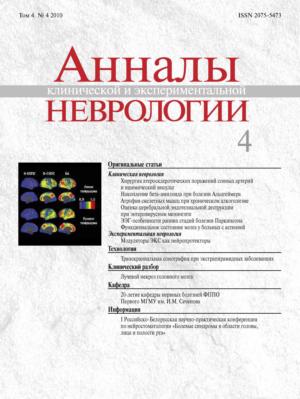Регионарная характеристика накопления бета-амилоида на доклинической и клинической стадиях болезни Альцгеймера
- Авторы: Власенко А.Г.1, Morris J.C.1, Minton M.A.1
-
Учреждения:
- Медицинский факультет Вашингтонского университета
- Выпуск: Том 4, № 4 (2010)
- Страницы: 10-14
- Раздел: Оригинальные статьи
- Дата подачи: 03.02.2017
- Дата публикации: 13.02.2017
- URL: https://annaly-nevrologii.com/journal/pathID/article/view/328
- DOI: https://doi.org/10.17816/psaic328
- ID: 328
Цитировать
Полный текст
Аннотация
Накопление бета-амилоида (Ab) в виде сенильных бляшек в коре головного мозга является одним из наиболее характерных патоморфологических признаков болезни Альцгеймера (БА). Согласно концепции доклинической стадии БА, накопление Ab может отмечаться задолго до появления клинической симптоматики. В настоящем исследовании мы рассчитали уровень накопления Ab в различных областях головного мозга с помощью радиофармпрепарата N-метил-[11C]2-(4’-метиламинофенил)-6-гидроксибензотиазола ([11C]PIB) у 16 больных с умеренно выраженной деменцией альцгеймеровского типа (ДАТ) и у 223 человек в возрасте от 50 до 86 лет, у которых не отмечалось каких-либо когнитивных расстройств. Пороговый уровень, превышение которого свидетельствует о патологическом характере накопления Ab, определяли по среднему значению потенциала связывания [11C]PIB для четырех участков коры головного мозга с наиболее высоким Ab. В обеих группах — и с низким (n = 181), и с высоким (n = 42) уровнем Ab — наибольшее накопление [11C]PIB отмечалось в предклинье. У больных с ДАТ уровень Ab был существенно выше, чем у клинически бессимптомных лиц во всех исследованных участках головного мозга с максимальными значениями в области предклинья и префронтальных отделах коры. Полученные данные свидетельствуют, что предклинье является областью коры головного мозга, которая наиболее рано вовлекается в процесс накопления Ab.
Об авторах
Андрей Геннадьевич Власенко
Медицинский факультет Вашингтонского университета
Email: andrei@npg.wustl.edu
США, Сент-Луис
J. C. Morris
Медицинский факультет Вашингтонского университета
Email: andrei@npg.wustl.edu
США, Сент-Луис
M. A. Minton
Медицинский факультет Вашингтонского университета
Автор, ответственный за переписку.
Email: andrei@npg.wustl.edu
США, Сент-Луис
Список литературы
- Agdeppa E.D., Kepe V., Liu J. et al. Binding characteristics of radiofluorinated 6-dialkylamino-2-naphthylethylidene derivatives as positron emission tomography imaging probes for beta-amyloid plaques in Alzheimer’s disease. J. Neurosci. 2001; 21: RC189.
- Berg L. Clinical Dementia Rating (CDR). Psychopharmacol. Bull. 1988; 24: 637–639.
- Braak H., Braak Е. Neuropathological stageing of Alzheimer-related changes. Acta Neuropathol. (Berl.) 1991; 82: 239–259.
- Bradley K.M., O’Sullivan V.T., Soper N.D. et al. Cerebral perfusion SPET correlated with Braak pathological stage in Alzheimer’s disease. Brain 2002; 125: 1772–1781.
- Cavanna A.E., Trimble M.R. The precuneus: a review of its functional anatomy and behavioral correlates. Brain 2006; 129: 564–583.
- Corder E.H., Saunders A.M., Strittmatter W.J. et al. Gene dose of apolipoprotein E type 4 allele and the risk of Alzheimer’s disease in late onset families. Science 1993; 261: 921–923.
- Dickerson B.C. New frontiers in computational analysis of human hippocampal anatomy. Hippocampus 2009; 19: 507–509.
- Edison P., Archer H.A., Hinz R. et al. Amyloid, hypometabolism, and cognition in Alzheimer disease. An [11C]PIB and [18F]FDG PET study. Neurology 2007; 68: 501–508.
- Fagan A.M., Mintun M.A., Mach R.H. et al. Inverse relation between in vivo amyloid imaging load and cerebrospinal fluid Abeta42 in humans. Ann. Neurol. 2006; 59: 512–519.
- Hardy J., Allsop D. Amyloid deposition as the central event in the aetiology of Alzheimer’s disease. Trends Pharmacol. Sci. 1991; 12: 383–388.
- Hardy J., Duff K., Hardy K.G. et al. Genetic dissection of Alzheimer’s disease and related dementias: amyloid and its relationship to tau. Nat. Neurosci. 1998; 1: 355–358.
- Hardy J., Selkoe D.J. The amyloid hypothesis of Alzheimer’s disease: progress and problems on the road to therapeutics. Science 2002; 297: 353–356.
- Hardy J.A., Higgins G.A. Alzheimer’s disease: the amyloid cascade hypothesis. Science 1992; 256: 184–185.
- Hedden T., Van Dijk K.R., Becker J.A. et al. Disruption of functional connectivity in clinically normal older adults harboring amyloid burden. J. Neurosci. 2009; 29: 12686–12694.
- Huang C., Wahlund L.O., Svensson L. et al. Cingulate cortex hypoperfusion predicts Alzheimer’s disease in mild cognitive impairment. BMC Neurol. 2002; 2: 9.
- Hulette C.M., Welsh-Bohmer K.A., Murray M.G. et al. Neuropathological and neuropsychological changes in «normal» aging: evidence for preclinical Alzheimer disease in cognitively normal individuals. J. Neuropathol. Exp. Neurol. 1998; 57: 1168–1174.
- Ikonomovic M.D., Klunk W.E., Abrahamson E.E. et al. Post-mortem correlates of in vivo PiB-PET amyloid imaging in a typical case of Alzheimer’s disease. Brain 2008; 131: 1630–1645.
- Kemp P.M., Hoffmann S.A., Holmes C. et al. The contribution of statistical parametric mapping in the assessment of precuneal and medial temporal lobe perfusion by 99mTc-HMPAO SPECT in mild Alzheimer’s and Lewy body dementia. Nucl. Med. Commun. 2005; 26: 1099–1106.
- Klunk W.E., Engler H., Nordberg A. et al. Imaing brain amyloid in Alzheimer’s disease with Pittsburgh Compound-B. Ann. Neurol. 2004; 55: 306–319.
- Kogure D., Matsuda H., Ohnishi T. et al. Longitudinal evaluation of early Alzheimer’s disease using brain perfusion SPECT. J. Nucl. Med. 2000; 41: 1155–1162.
- Leinonen V., Alafuzoff I., Aalto S. et al. Assessment of beta-amyloid in a frontal cortical brain biopsy specimen and by positron emission tomography with carbon 11-labeled Pittsburgh Compound B. Arch. Neurol. 2008; 65: 1304–1309.
- Logan J., Fowler J.S., Volkow N.D. et al. Graphical analysis of reversible radioligand binding from time-activity measurements applied to [N-11C-methyl]-(-)-cocaine PET studies in human subjects. J. Cereb. Blood Flow Metab. 1990; 10: 740–747.
- Logan J., Fowler J.S., Volkow N.D. et al. Distribution volume ratios without blood sampling from graphical analysis of PET data. J. Cereb. Blood Flow Metab. 1996; 16: 834–840.
- Lustig C., Snyder A.Z., Bhakta M. et al. Functional deactivations: change with age and dementia of the Alzheimer type. Proc. Natl. Acad. Sci. U.S.A 2003; 100: 14504–14509.
- Minoshima S., Giordani B., Berent S. et al. Metabolic reduction in the posterior cingulate cortex in very early Alzheimer’s disease. Ann. Neurol. 1997; 42: 85–94.
- Mintun M.A., Larossa G.N., Sheline Y.I. et al. [11C]PIB in a nondemented population: potential antecedent marker of Alzheimer disease. Neurology 2006; 67: 446–452.
- Morris J.C. The Clinical Dementia Rating (CDR): current version and scoring rules. Neurology 1993; 43: 2412–2414.
- Morris J.C., Price A.L. Pathologic correlates of nondemented aging, mild cognitive impairment, and early-stage Alzheimer’s disease. J. Mol. Neurosci. 2001; 17: 101–118.
- Morris J.C., Roe C.M., Grant E.A. et al. Pittsburgh compound B imaging and prediction of progression from cognitive normality to symptomatic Alzheimer disease. Arch Neurol. 2009; 66: 1469–1475.
- Morris J.C., Roe C.M., Xiong C. et al. APOE predicts amyloid-beta but not tau Alzheimer pathology in cognitively normal aging. Ann. Neurol. 2010; 67: 122–131.
- Price D.L., Sisodia S.S. Mutant genes in familial Alzheimer’s disease and transgenic models. Annu. Rev. Neurosci. 1998; 21: 479–505.
- Price J.C., Klunk W.E., Lopresti B.J. et al. Kinetic modeling of amyloid binding in humans using PET imaging and Pittsburgh Compound- B. J. Cereb. Blood Flow Metab. 2005; 25: 1528–1547.
- Raichle M.E., MacLeod A.M., Snyder A.Z. et al. A default mode of brain function. Proc. Natl. Acad. Sci USA 2001; 98: 676–682.
- Reiman E.M., Caselli R.J., Yun L.S. et al. Preclinical evidence of Alzheimer’s disease in persons homozygous for the epsilon 4 allele for apolipoprotein E. N. Engl. J. Med. 1996; 334: 752–758.
- Sakamoto S., Matsuda H., Asada T. et al. Apolipoprotein E genotype and early Alzheimer’s disease: a longitudinal SPECT study. J. Neuroimaging 2003; 13: 113–123.
- Salmon E., Collette F., Degueldre C. et al. Voxel-based analysis of confounding effects of age and dementia severity on cerebral metabolism in Alzheimer’s disease. Hum. Brain Mapp. 2000; 10: 39–48.
- Selemon L.D., Goldman-Rakic P.S. Common cortical and subcortical targets of the dorsolateral prefrontal and posterior parietal cortices in the rhesus monkey: evidence for a distributed neural network subserving spatially guided behavior. J. Neurosci. 1988; 8: 4049–4068.
- Selkoe D.J. Soluble oligomers of the amyloid beta-protein impair synaptic plasticity and behavior. Behav. Brain Res. 2008; 192: 106–113.
- Sheline Y.I., Raichle M.E., Snyder A.Z. et al. Amyloid plaques disrupt resting state default mode network connectivity in cognitively normal elderly. Biol. Psychiatry 2010; 67: 584–587.
- Shulman G.L., Fiez J.A., Corbetta M. et al. Common blood flow changes across visual tasks: II. Decreases in cerebral cortex. J. Cognit. Neurosci. 1997; 9: 648–663.
- Small G.W., Ercoli L.M., Silverman D.H. et al. Cerebral metabolic and cognitive decline in persons at genetic risk for Alzheimer’s disease. Proc. Natl. Acad. Sci. USA 2000; 97: 6037–6042.
- Small S.A., Duff K. Linking Abeta and tau in late-onset Alzheimer’s disease: a dual pathway hypothesis. Neuron 2008; 60: 534–542.
- Storandt M., Mintun M.A, Head D., Morris J.C. Cognitive decline and brain volume loss as signatures of cerebral amyloid-beta peptide deposition identified with Pittsburgh compound B: cognitive decline associated with Abeta deposition. Arch. Neurol. 2009; 66: 1476–1481.
- Tanzi R.E., Kovacs D.M., Kim T.W. et al. The gene defects responsible for familial Alzheimer’s disease. Neurobiol. Dis. 1996; 3: 159–168.
- Tomlinson B.E., Blessed G., Roth M. Observations on the brains of non-demented old people. J. Neurol. Sci. 1968; 7: 331–356.
- Verhoef N., Wilson A.A., Takeshita S. et al. In vivo imaging of Alzheimer disease β-amyloid with [ 1 1 C]SB-13 PET. Am. J. Geriatr. Psychiatry 2004; 12: 584–595.
- Vaishnavi S.N., Vlassenko A.G., Rundle M.M. et al. Regional aerobic glycolysis in the human brain. [published online ahead of print September 13 2010] Proc. Natl. Acad. Sci. USA. www.pnas.org/cgi/doi/10.1073/pnas.1010459107.
- Vlassenko A.G., Vaishnavi N.S., Couture L. et al. Spatial correlation between brain aerobic glycolysis and A deposition. [published online ahead of print September 13 2010] Proc. Natl. Acad. Sci. USA www.pnas.org/cgi/doi/10.1073/pnas.1010461107.
- Wong D.F., Rosenberg P.B., Zhou Y. et al. In vivo imaging of amyloid deposition in Alzheimer disease using the radioligand 18F-AV-45 (florbetapir [corrected] F 18). J. Nucl. Med. 2010; 51: 913–920.
Дополнительные файлы








